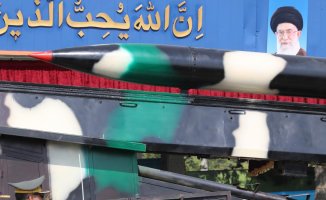The president of Colombia, Iván Duque, has announced the discovery of two vessels near the area where the Spanish galleon San José is located, sunk off the coast of Cartagena de Indias, Colombia, by British corsairs and discovered in 2015. "We have records of around a dozen similar vessels whose location is being investigated by Navy teams," the Colombian president assured.
He also explained that they have bought "equipment in recent years to be able to reach the depths and have the best images" and at the same time protect "the integrity of the treasure" and preserve and protect it until the extraction can be carried out, whose rescue is up for bid.
"In recent years, with these technologies we were able to reach a level of precision never seen before," said Duque, adding that the new equipment has also been used to carry out explorations "where there was prior preliminary information on possible shipwrecks in similar times" and so they have reached the location of these two boats.
These teams have also made it possible to verify, according to the commander of the Navy, Admiral Gabriel Pérez, that "the area where the San José Galleon is located had not been intervened in any way by anthropic means or by the hand of man."
The General Maritime Director, José Joaquín Amézquita, has also highlighted that other finds have been discovered in the photographs of the San José Galleon, such as intact crockery from the time, with the insignia of the galleon, or details of the cannons made in Seville and Cádiz. about the year 1655.
There are also macuquinas, the coin minted by hand in Spanish America, a gold ingot and the crew's swords. "What we are talking about is an important wealth that has a lot to tell us about our past," said Amézquita.
THE CASE OF SAN JOSE
The San José was sunk by a fleet of English corsairs on June 8, 1708 when it was on its way to Cartagena de Indias loaded, according to chronicles of the time, with nearly 11 million gold and silver eight-escudo coins that it had collected in the fair of Portobelo, Panama. The shipwreck occurred during the battle of Barú by the flagship of the British fleet, the Expedition.
After the announcement of the discovery of the wreck, in December 2015, disputes arose between Colombia and Spain because the latter country claims that, because it is a "state ship", it is protected by the rules of the United Nations Organization for Education, Science and Culture to claim ownership.
To rescue the San José, the previous Colombian Executive launched a contracting process through a public-private alliance that would be paid mainly with pieces rescued from the wreck, but the Administration of his successor, Iván Duque, suspended it for fear that may lose national heritage. Last March, the president announced that "it is protected cultural heritage and we do not want to hand over part of it as payment."
The discovery of these new boats reopens the debate on the rescue of the merchandise and the way in which the loot would be distributed. The Colombian government will make a new call with international experts and archaeologists to extract the galleon, discovered seven years ago.













